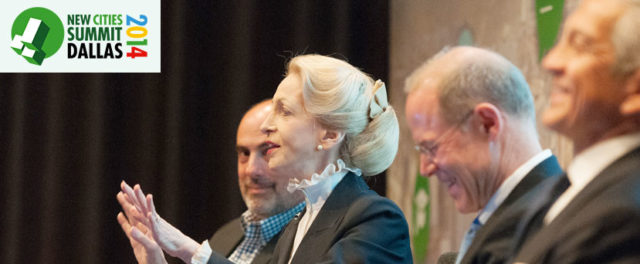
Financing Urban Transformation
novembre 21, 2014 — Uncategorized
This post is part of our Re-imagining Cities discussion series, following the third edition of the NewCities Summit in Dallas in June 2014.
Financing transformation in the 21st century of cities required creative financial engineering and private/public partnerships. Key topics addressed during this session included the potential solutions, the need for infrastructure investments across the globe, and the growing population. Professor John Macomber began the workshop by giving a mini-finance lesson. City projects are difficult to compare, he said. He mentioned some caveats. Firstly, there is plenty of capital but not enough bankable projects. Secondly, beware of vendors with a vested interest in making a project as complex as possible. He explained that there are roughly three ways to pay for projects: taxes, tariffs and transfers. The best approaches to financing transformation are seed funding, financial engineering where different entities take risk, privatization that defines clearly the scope of services, quantified financial externalities, informal value capture, and taking a long-term view. He emphasized that in creating investment vehicles there were lots of ways to split cash flows.

Lady Barbara Judge took the panel to the global stage with her presentation on the role of pension funds in financing infrastructure. She explained that as chairperson of a 16 billion euro pension fund, the money is there to invest but due to the nature of pension funds, they are conservative investors. Their goal, she said, was to invest from 5-15% in projects. She gave examples of toll roads, airports and water treatment plants. She asserted that pension funds do not like risk, and there needs to be a first line set of lenders that can help with projects from scratch with reliable builders and contractors.
Javier Palomarez took the discussion from the global to the US market. He specifically addressed the trends he has observed in business investment within the Hispanic community. He noted that the Hispanic population is booming: it is the largest minority ethnic group in the United States with a powerful purchasing power of US$1.5 trillion. Cities need to tap into this market as productivity and population go hand in hand.
Cities need to protect themselves from signing bad deals. “We assume good intent, competence and good transparency,” but that may not be the case – Professor Macomber
Professor Macomber then noted that financial vehicles, such as performance contracting, are creative ways to finance city projects. However, cities need to protect themselves from signing bad deals. “We assume good intent, competence and good transparency,” but that may not be the case. This becomes particularly obvious when dealing with cash-strapped cities. So many things citizens need do not necessarily generate an income, and the focus needs to be on infrastructure projects that can create income. Lady Judge mentioned that having good visionary leaders also could help solve these issues in bringing people together. Palomarez finalized the discussion with the point that what lies ahead is the need for job creation, leadership and transparency. Cities also need to keep in mind that two-thirds of all jobs are created by small businesses. Thus, public/private sector investment in urban settings should be a major priority.
Speakers
- Lady Barbara Judge, Chairman, UK Pension Protection Fund & Former Chairman, UK Atomic Energy Authority
- John Macomber, Senior Lecturer – Finance, Harvard Business School – @cleantechcities
- Javier Palomarez, President & Chief Executive Officer, United States Hispanic Chamber of Commerce – @JPalomarez
Moderated by: Mark Paris, Managing Director, Citi
